Consider two paintings.
One is (1933), by the early 20th century spiritual-abstractionist painter Agnes Pelton. She is the star of a show that has just arrived at the Whitney Museum, part of a wave of recent interest in experimental art by previously unsung or undersung female artists working in esoteric or occult traditions, a vogue that is currently rewriting how museums approach the history of modern art.
centers on a cluster of numinous blobs in pale lavender, pink, and turquoise pastels, set off against a red and black background and wreathed by precisely organized whorls of energy. It suggests the form of a seated Buddha.
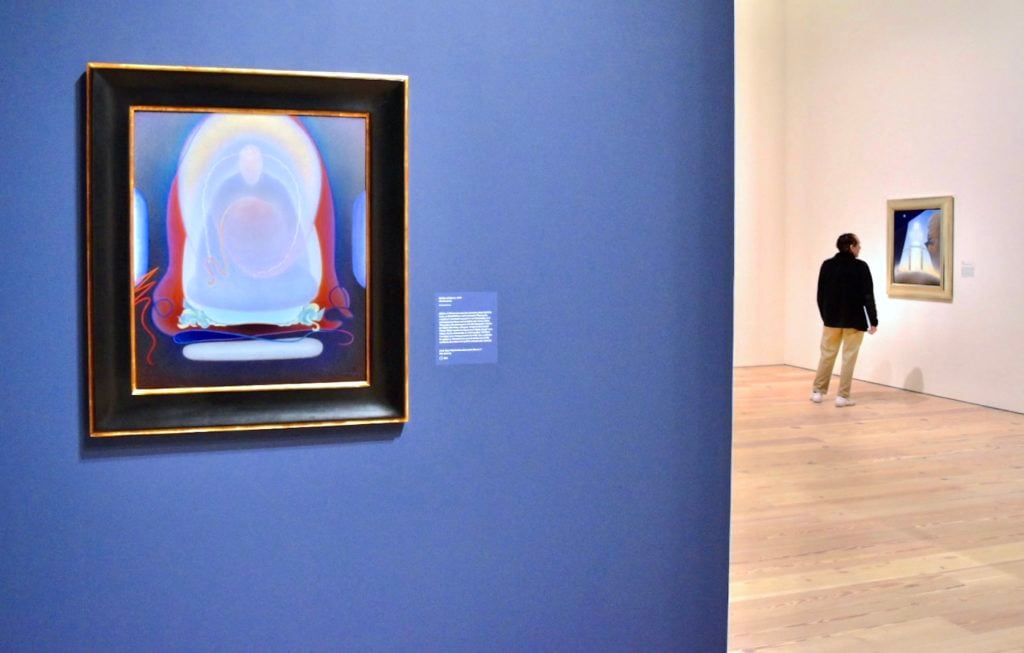
Installation view of Agnes Pelton, at the Whitney. Image: Ben Davis.
Now consider a painting not in the show, (1924), by the Russian painter, set designer, adventurer, and mystic Nikolai Roerich. In rich tones and flattened perspective, it depicts the veiled figure of the ultimate female goddess in Roerich’s occult system, seated on her mountain throne and framed by divine halos.
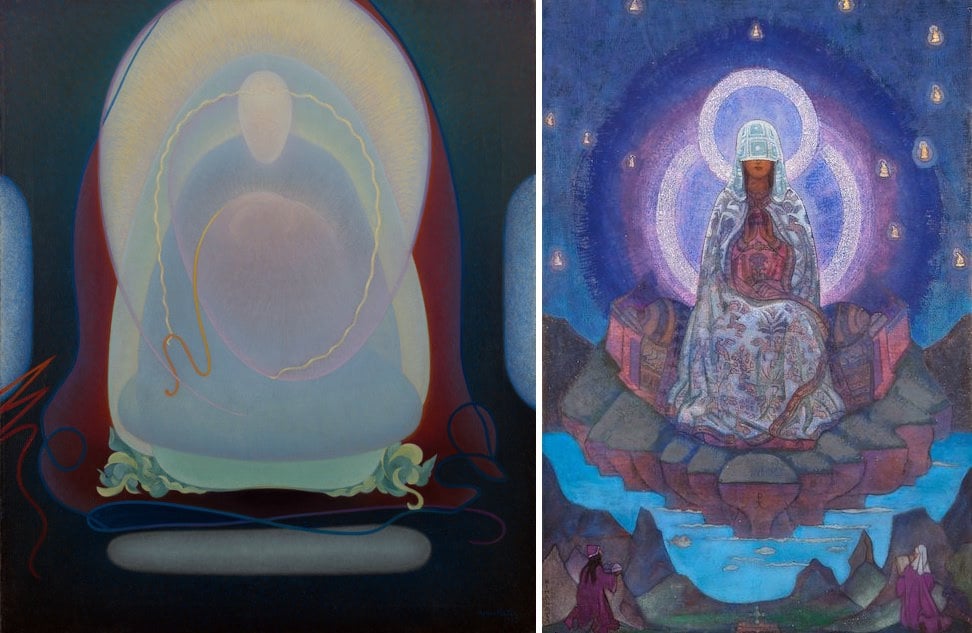
Left to right: Agnes Pelton, (1933) and Nicholas Roerich, (1924).
Look at the two together and you get a clear sense of the kind of archetypal image that Pelton is adumbrating in her abstraction. I have no idea if Pelton is referencing this exact image. However, both she and her art both were deeply inspired by Agni Yoga, the doctrine that Nicolas Roerich and his wife Helena dreamed up in the 1920s, claiming to be channeling Eastern wisdom through spiritual séances.
Indeed, one of the rare figurative works in the Whitney show—and a slightly unsettling beat in its otherwise serenely otherworldly atmosphere—is (1933). This is Pelton’s portrait of Nicolas Roerich, rendered in gauzy, unearthly colors and full guru style, his beady-eyed gaze transfixing the viewer.
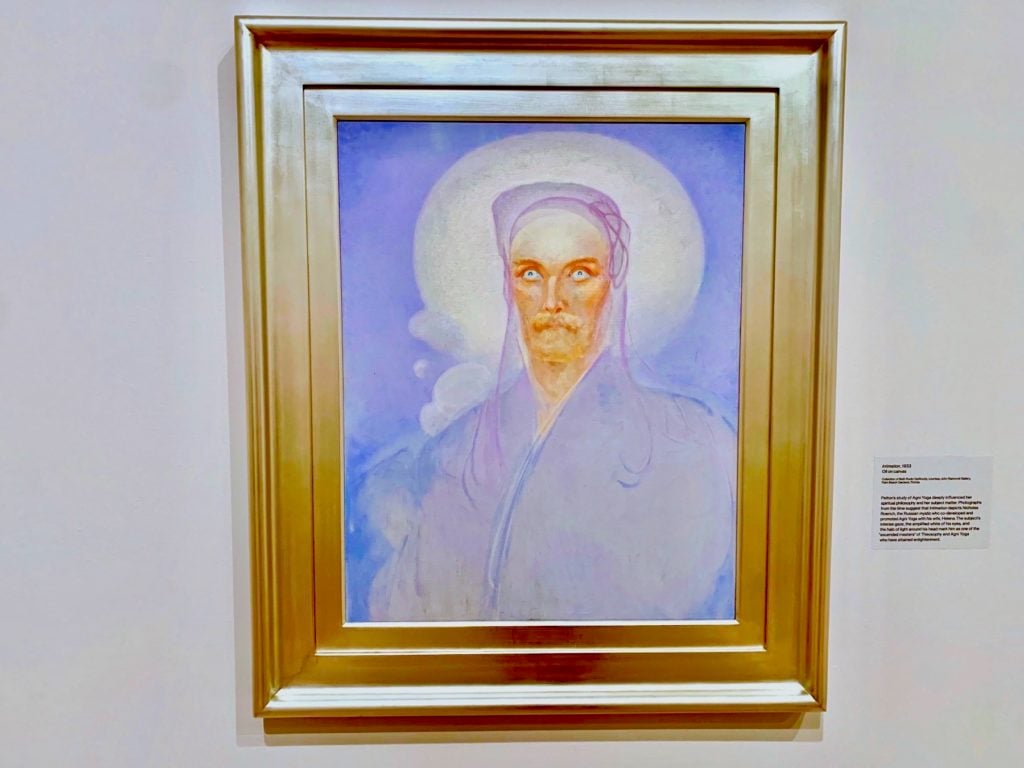
Agnes Pelton, (1933). Image: Ben Davis.
“Agni Yoga” meant “Path to the Divine Fire.” The Roerichs’ doctrine celebrated fire as the symbol of the energy animating all fixed things and all forms of wisdom, “the essence of the entire life, all-embracing, evading nought.” The veiled goddess of goddesses in Nicolas Roerich’s painting was conceived as his ultimate unifying symbol of the divine light, whose energy, he preached, would be at last unveiled when the coming “Age of Fire” dawned. Then, as the explains, “fiery energies will move toward the sphere of the Earth to purify it from a surrounding heavy atmosphere caused by the crimes committed by humans.”
In any case, these two works merit two linked comments, one formal, one symbolic.
The formal one is that Roarich’s painting clearly draws on Russian orthodox icon depictions of the Virgin, given a fanciful Buddhist-accent makeover. This conjugation makes sense, since Agni Yoga’s ideas were syncretic, promising to reveal the common secret wisdom at the root of all religions. Pictorially, however, it takes us towards devotional cliché.
The modernist abstraction of Pelton’s , on the other hand, makes for a quietly more awesome spin on the subject of a spiritual presence.
And at the same time, Pelton’s better fits what I take to be both works’ underlying idea: a goddess figure who incarnates the protean energy at the root of all earthly things. The miasmic, dreamy character of the Pelton painting is far more evocative of that idea than the deliberately stiff, folk art style of the Roerisch one.
The student surpasses the master here, or the acolyte outshines the guru.
***
“Agnes Pelton: Desert Transcendentalist,” which began at the Phoenix Art Museum, features 40-odd paintings by Pelton, of the only 100 or so abstractions she made during her life. She made figurative art too, tourist-friendly California landscapes (she actually called them “Tourist Paintings”) that she sold to support herself when money got tight during the Great Depression, but none are here. It was her more modernist works that she considered her calling.
“Always do ‘this’ work first, others only when these do not call you,” Pelton advised herself in her diary of the abstract works. She arrived at their forms via extensive meditation and trance, creating exact sketches of the seemingly aleatory constellations of forms and symbols that came to her in her notebooks before rendering them to canvas.
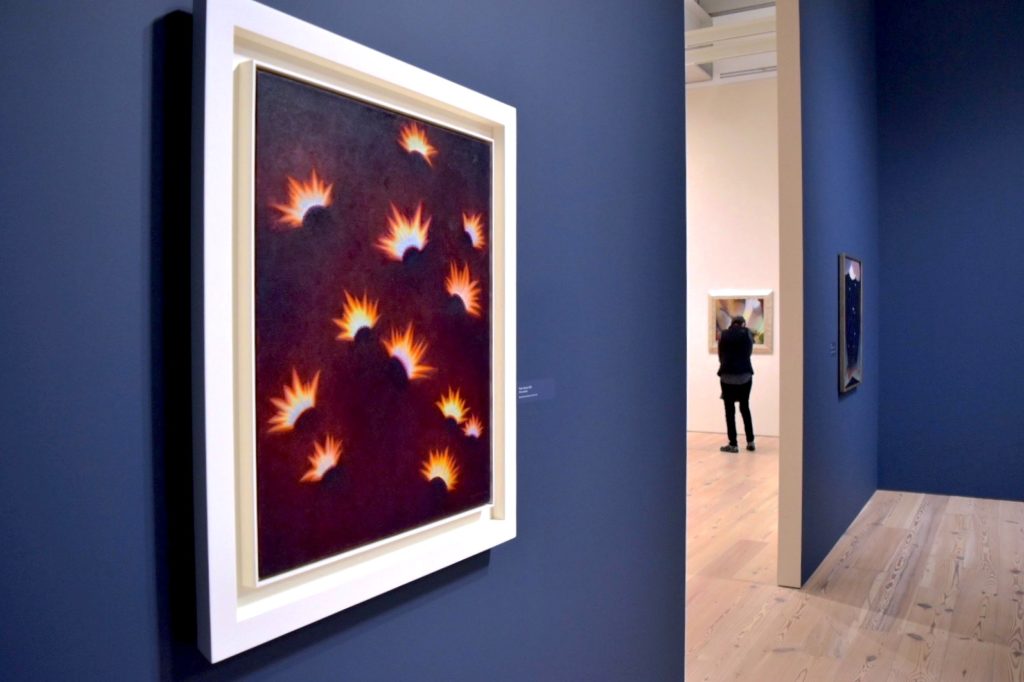
Agnes Pelton, (1938). Image: Ben Davis.
Without knowing anything about Agnes Pelton’s story, you would likely guess something about these paintings’ subject matter: solitude (by dint of their evocations of empty landscapes); healing (because of their gentle, nourishing color palette); and mysticism (because of their many occult symbols: evening stars, floating portals, roses, swans, lotus flowers, magic mountains, holy deserts, “windows of illumination” opening in space, and flares of the divine Roerichian fire breaking into reality).
Still, it’s worth knowing a bit about Pelton’s life story. Born in 1881, she was raised in the shadow of 19th-century Brooklyn’s most infamous sex scandal, the Beecher–Tilton Affair. Her grandmother, Elizabeth Tilton, had been exposed as having an affair with liberal preacher Henry Ward Beecher. Her grandfather, once a devout Beecher acolyte, sued for “alienation of affection.” Doubling his humiliation, he lost in court, and was estranged from the church and from Brooklyn society.
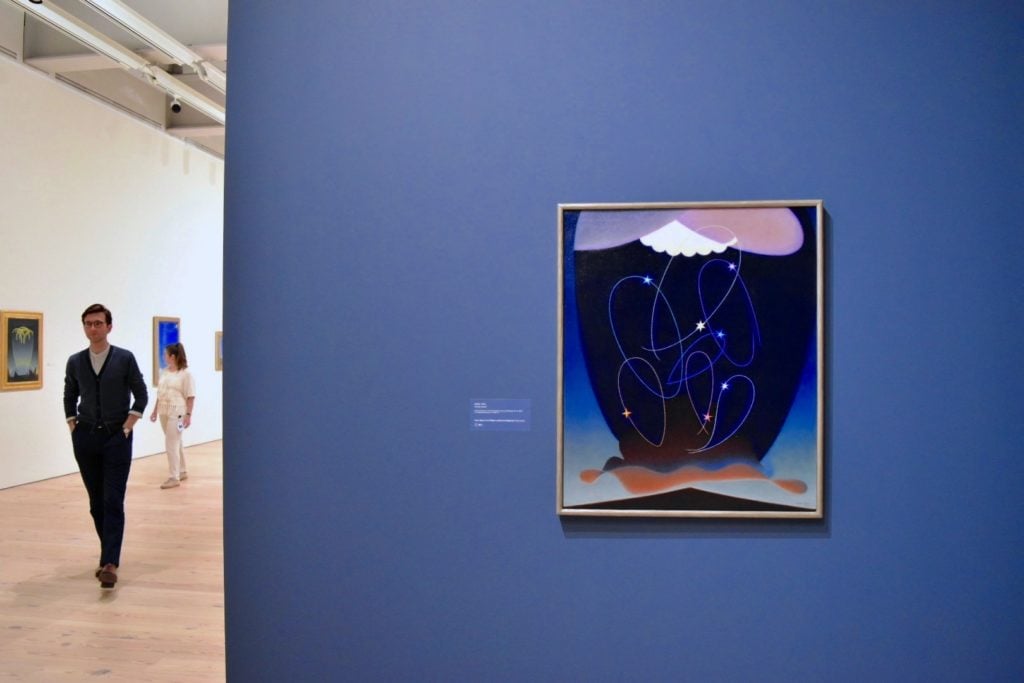
Agnes Pelton, (1934). Image: Ben Davis.
Of her family’s heritance of infamy, Pelton would remember that “it cramped our whole life and it also cramped mine…. [it] overshadowed me.” Her mother (who had been the one to report the infidelity) married a wealthy but troubled man from a Louisiana sugar empire. He died of morphine overdose in 1891. Young Agnes grew up “inclined to melancholy and tears,” surrounded by “deeply religious and perhaps unnecessarily serious people.” She was diagnosed with “neurotic fever” at 19, and may have had an eating disorder.
Pelton would find comfort in two things. One was art, which she studied at Pratt starting at 16, going on to paint portraits for money, and Symbolist-inspired canvasses out of passion. She would show at the 1913 Armory Show, the sensational survey that introduced ideas of modern art to still-provincial USA (Marcel Duchamp’s Cubistic was the big succès de scandale). There, Pelton’s work appeared alongside major names from future art history textbooks like Charles Sheeler and Marsden Hartley.
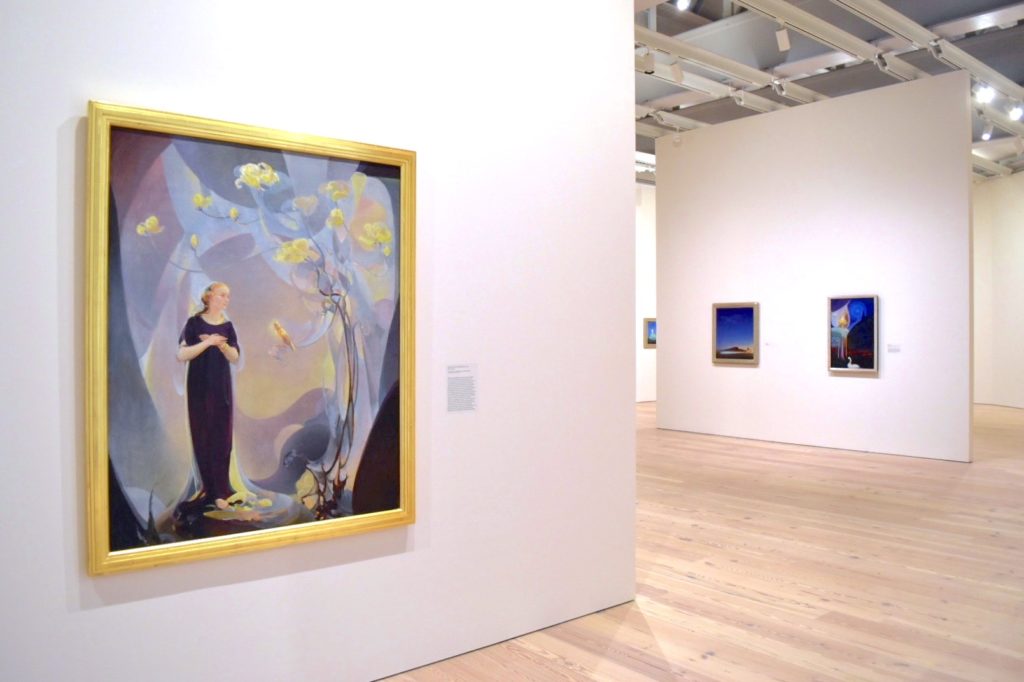
Agnes Pelton, (1917). Image: Ben Davis.
The Whitney features just one introductory example that gives a taste of Pelton’s early Symbolist mode of the 1910s, her “Imaginative Paintings.” It’s a large canvas—her largest, actually a painting for a mural—featuring a woman walking amid a secluded woodland scene that has a swirling, animate character. It skirts Symbolist kitsch (her own later judgment on these early works is that they were “insincere” and “not real”).
Nevertheless, the idea of the solo female seeker in communion with natural and cosmic forces was the foundation of all the more experimental work Pelton did—though a theme she would elaborate in less and less literal ways.
***
Pelton’s other comfort was alternative spirituality. In the 1920s, in her 40s, her mother died and she left New York to live in a windmill house on Long Island. She also developed a yen for Theosophy, the epiphanic slurry of pan-religious beliefs pioneered by Russian émigré and occult entrepreneur Helena Blavatsky. It was under the influence of Theosophical beliefs in accessing an abstract “Divine Reality” at the root of all reality and thought that Pelton began her experiments in abstraction, such as the (1925) and (1926), which suggest images of spiritual vibrations.

Agnes Pelton, (1926). Image: Ben Davis.
Her best works, however, are from a little later. In 1930, through an acquaintance with composer and “transpersonal astrologer” Dane Rudhyar, Pelton would discover the Roerichs’s Agni Yoga doctrine, a heretical elaboration of Theosophy that, in addition to spinning pages of alluring hokum out of the transcultural significance of fire, stressed self-help and moral improvement through spiritual living.
The Roerichs’ tome, , advised the reader: “In creation realize the happiness of life, and unto the desert turn thine eye.” In 1932, Pelton complied literally, moving West to Cathedral City, California, near Desert Hot Springs, where she found both the solitude in which she had always longed to work, as well as the community of others with similar esoteric interests.
Her first painting after her arrival literally “turned its eye” to the desert to find happiness: it depicts a floriform window of divine light, piercing through a sandstorm, conjuring a hardy, healing rainbow.
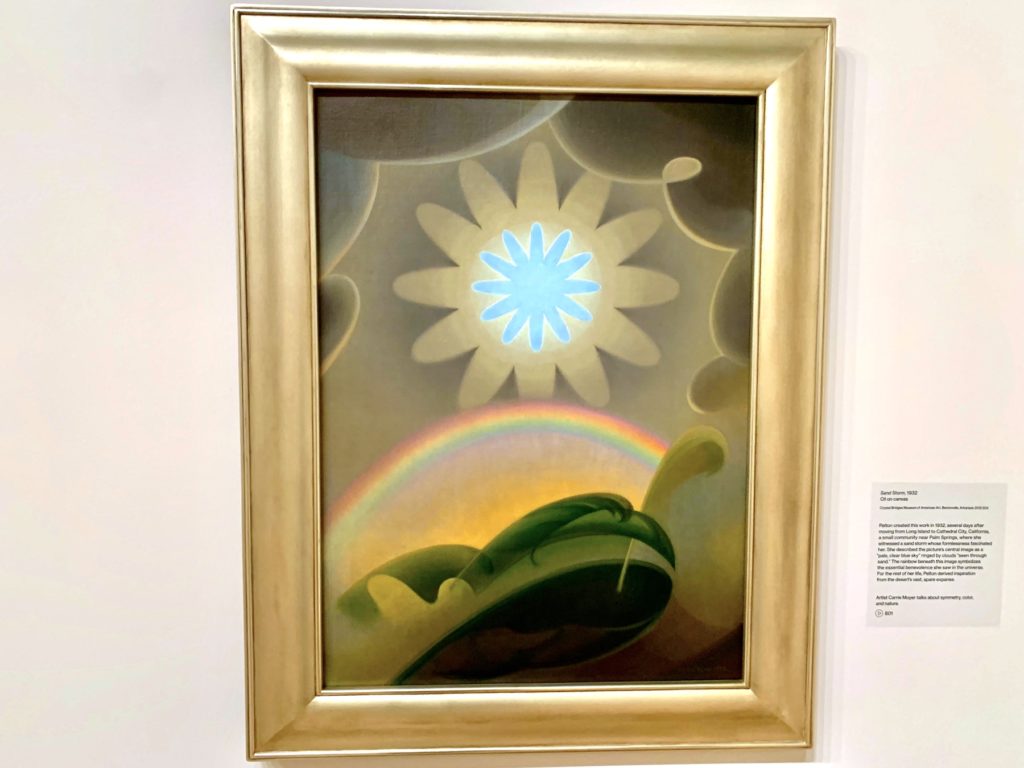
Agnes Pelton, (1932). Image: Ben Davis.
How to look at these paintings, with their wonky, hieratic quality? Part of their appeal is their exotic sense of marshaling secret totems and magical signs, but a lot of their esoteric symbolism remains remote. I also think the search for a master code might miss the point of the imagery for Pelton herself.
Pelton’s family history had been scarred by the rigidity, coldness, dogma, and moral judgementalism of New York’s Gilded Age religious society. Aside from offering the spiritual warmth of a literal fire cult, proto-New Age philosophies like Agni Yoga appealed because they were notably eclectic—they encouraged curiosity in the whole panoply of world religions, and you could take from them what you wanted, in a highly personal way.
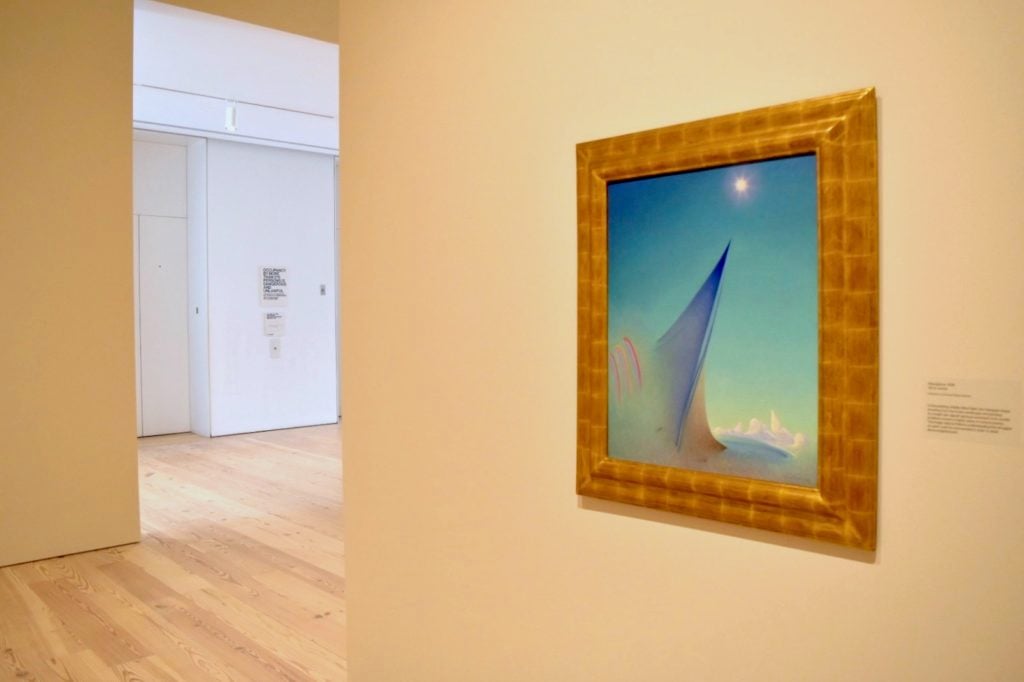
Agnes Pelton, (1938). Image: Ben Davis.
Pelton seems to have read deeply and widely and forged her own synthesis to meet her own devotional needs. As much as evokes Roerich’s goddess of divine fire, for instance, it also seems to have been for the artist an avatar of her own mother’s spirit as well. In Pelton’s California studio, she kept the canvas near her, to commune with its spirit for advice on painting and to give her comfort in times of money woes.
In their day—the day of high modernism, after all—the appealing aspect of these modern occult philosophies was the sense of metaphysical order and higher truth, alongside the freedom from old religious rigidities and the ability to make one’s own path. This balance is coded into the formal vocabulary of Pelton’s canvasses. Her art gives a comfortingly ordered, hieroglyphic form to symbols of protean, unbounded spiritual potential: holy fire (, 1932), swelling oceans (, 1931), rippling atmosphere (, 1938).
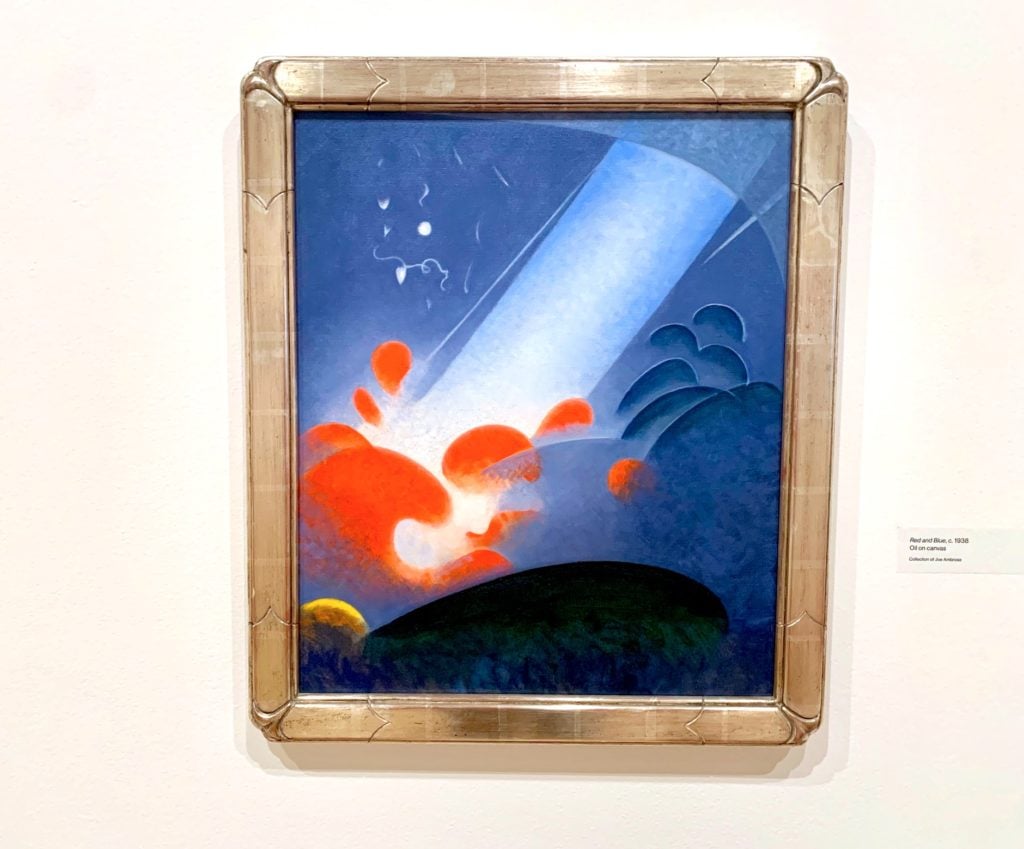
Agnes Pelton, (ca. 1938). Image: Ben Davis.
What is true within the canvasses is also true between them: Pelton’s art embodies a protean spirit in that she never really repeats an idea.
There is, clearly, a signature mix of abstract forms, allusions to landscape, and far-out symbolism. But each composition is distinctly a new idea—and you can’t help but imagine that the singularity of each is part of what each symbolizes, and that this is part of how Pelton’s art signifies for her that she was in touch with the energy that always changes, that doesn’t degenerate into doctrinal formulae, that carries her away from the world’s fixed hardships.
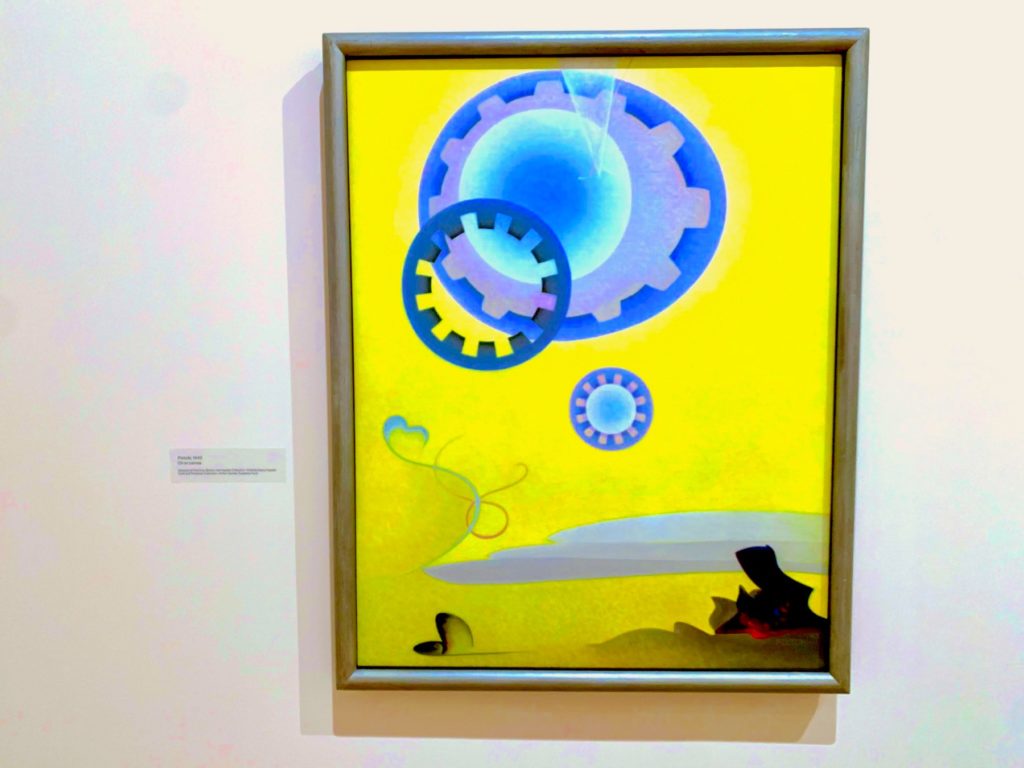
Agnes Pelton, (1943). Image: Ben Davis.
Again, formal and symbolic pleasures align here. This restlessly questing spiritual imperative is part of what makes Pelton’s art a font of pleasant surprises. Just when you think you’ve got her style figured out, there appears something like (1943), with its saffron sky blossoming with floating gear shapes. Where’d that come from?
***
Maybe all this is just to say that as much as Agnes Pelton’s art answered a spiritual call and an inner necessity, she also was a trained artist and brought an artist’s instinct for formal freshness to her quiet desert studio.
Though she did not experience huge success in her lifetime, Pelton showed her spiritual-abstract works at such non-arcane institutions as the San Diego Museum of Art, San Francisco Museum of Modern Art, the Crocker Art Museum, and the Santa Barbara Museum of Art. She certainly seemed to have believed that she was bringing into the world images with a higher mystical significance, but unlike more mediumistically inspired artists, Pelton signed her finished canvasses with her name, at the bottom corner, like someone who expected to be recognized.
Still, a small reason exists to think that constant change was the symbolic life force of Pelton’s art. Throughout the decades of her oeuvre as seen at the Whitney, she never repeats herself—except once.
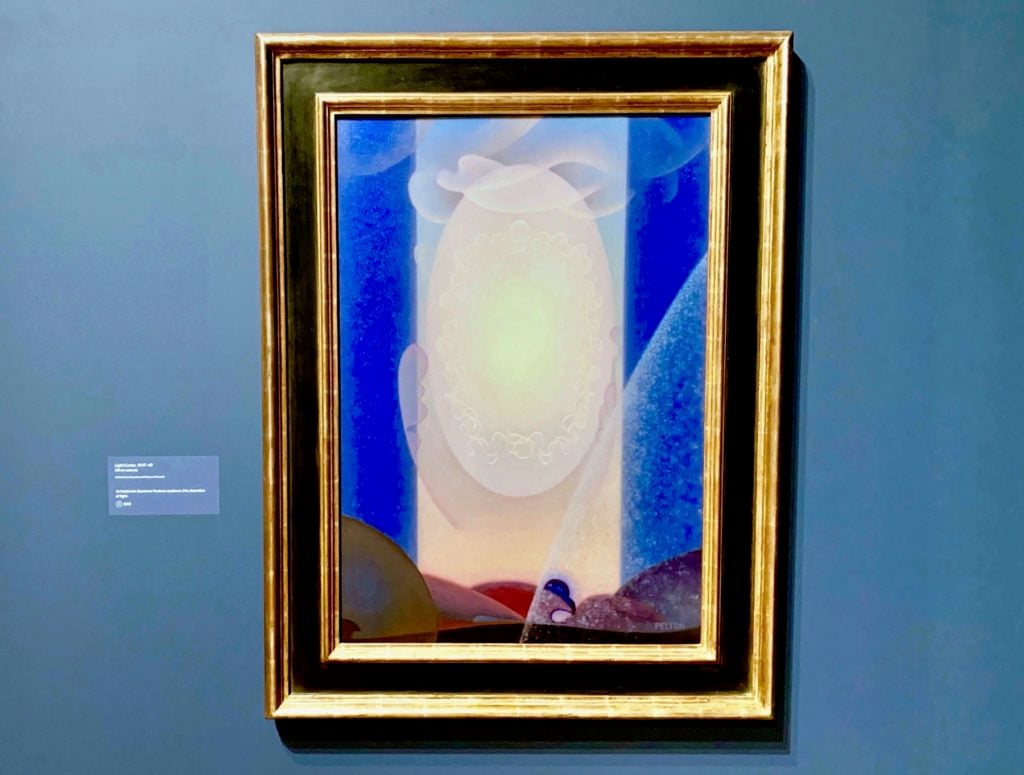
Agnes Pelton, (1947-48). Image: Ben Davis.
In 1947-48, Pelton made a work called , a hovering ovoid of energy suspended between an animate, rippling earth and a gauzy, serenely agitated sky.
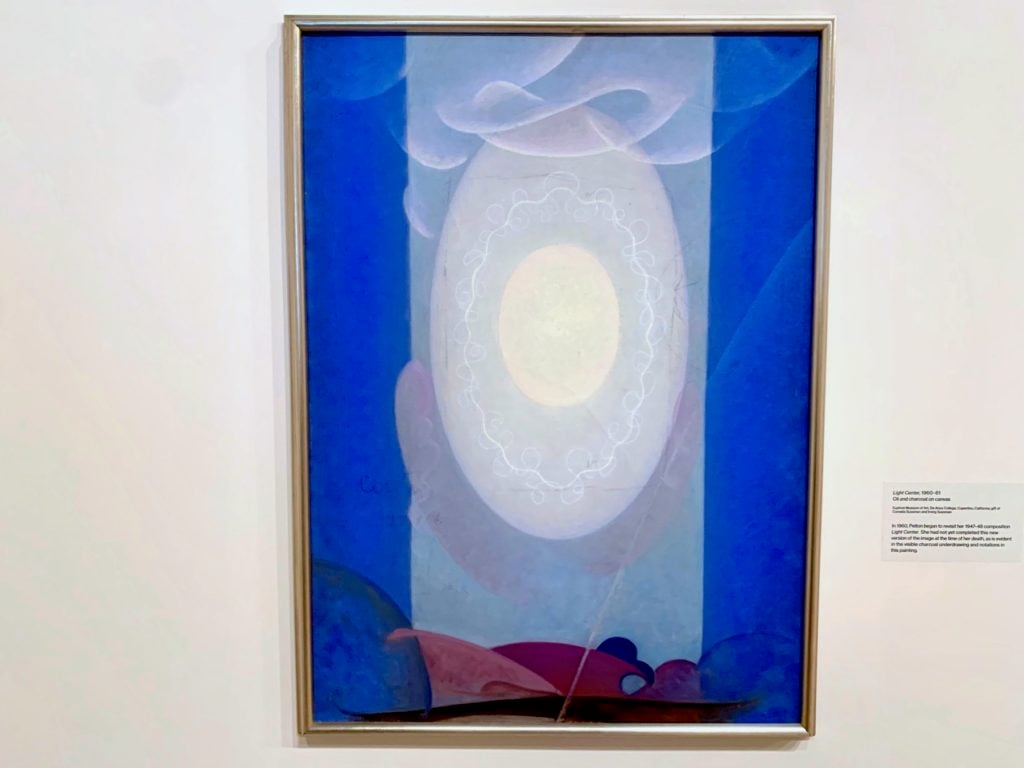
Agnes Pelton, (1960-61). Image: Ben Davis.
In 1960-61, she repeated the same composition, clearly. There are charcoal lines on the canvas still, where you see her trying to plot how exactly to tweak the image to make it repeat. They remain on the work because she died before she finished it.
Who knows why she turned, at that moment, to her own art for inspiration instead of to the spirits. But it is a beautiful thought that someone who had been looking for wisdom from the beyond, at the moment when she merged with it, finally let herself take inspiration from herself.
Source: Exhibition - news.artnet.com



